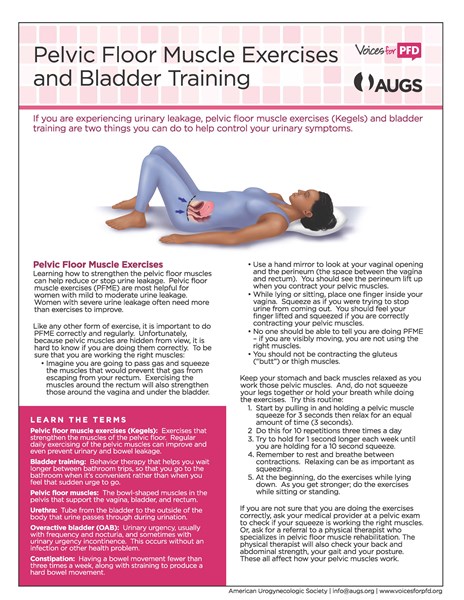Pelvic floor physical therapy starts with an assessment by a specially trained physical therapist (PT). The initial evaluation typically includes:
- Checking the motor control, strength, and endurance of core support muscles.
- Assessing your pelvic floor muscle coordination for different activities and positions.
- Other testing, as needed.
Based on the findings of this exam, the PT creates a treatment plan to help you improve your pelvic floor function. The treatment plan may include working with you on behavioral approaches such as bladder re-training techniques. Plus, an individualized physical therapy regimen to help rehab your pelvic floor muscles. The PT may use a variety of techniques. Specific treatments help to improve urinary and/or fecal continence.
 Kegels
Kegels
Pelvic floor muscle exercise (Kegels) help you to strengthen your pelvic floor and better control your bladder. However, sometimes women need help ensuring they are correctly performing Kegels. Research demonstrates that women who are trained in Kegels experience better outcomes. PTs often walk women through the steps of Kegels and help women work on their technique, as needed.
Biofeedback
Biofeedback is a technique that uses different types of devices to give information on how well pelvic muscles are contracting. The message or “feedback” can help improve awareness and control of pelvic floor muscles. These techniques are added to a pelvic muscle exercise program for women who have not reached their goals of symptom improvement. Biofeedback can be given through:
- A therapist who touches the muscles that are being contracted.
- A computer screen that shows through sounds or pictures, if the pelvic muscles are contracting and the other muscles groups are relaxed. This is done by connecting the computer to small sensors in the vagina or rectum and on the skin of the abdomen and legs.
Another type of biofeedback uses vaginal weight training. These cone shaped plastic objects of increasing weight can help strengthen vaginal muscles. They are placed in the vagina for a short time (15 to 30 minutes). By gripping or hugging the cones to keep them in place, women are contracting their pelvic muscles. The PT guides you as you hold progressively heavier cones in your vagina for longer periods of time, both standing and walking. Vaginal weights can also be used at home.
Percutaneous Tibial Nerve Stimulation (PTNS)
Pelvic floor electrical stimulation helps to strengthen the pelvic floor muscles. Your physical therapist may use an external nerve stimulator. In addition, doctors sometimes recommend an internal, permanently implanted nerve stimulation. Learn more about this type of nerve stimulation in the Procedures & Surgery section.
Percutaneous Tibial Nerve Stimulation (PTNS) is a non-surgical way to deliver electrical stimulation through a series of office treatments. The physical therapist or doctor places a thin needle near your ankle and then connects it to a battery-powered stimulator. After turning on the stimulator, mild electrical impulses travel up the nerves in the leg to the nerves that control your bladder. Your physician observes your body’s response to determine the ideal level for nerve stimulation. Most women receive 12 weekly, 30-minute treatments to start. After that, you may also need occasional treatments, usually about once to maintain improved bladder control. PTNS is often used along with Kegel exercises.